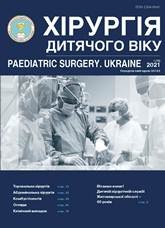Clinical case of multiple intestinal perforations caused by magnets
DOI:
https://doi.org/10.15574/PS.2021.70.80Keywords:
foreign bodies of digestive tract, perforation, magnetsAbstract
Gastrointestinal foreign bodies in children are a common reason for emergency surgical care. Among the foreign bodies of the digestive tract, special attention should be paid to neodymium magnets, known for their strong magnetic abilities and high resistance to demagnetization. The usual age of hospitalized children with intestinal magnetic bodies is 2–4 years. Swallowing neodymium balls can be accompanied with perforation, fistula, intestinal obstruction, peritonitis, shot bowel syndrome; septic condition with fatalities.
The article presents a clinical case of swallowing 17 magnets by two-years-old boy for a long time. The child was hospitalized without anamnestic date of foreign bodies to the digestive tract. Intestinal magnets were diagnosed radiological. Early surgery with gentle tactics was used. The child recovered.
The research was carried out in accordance with the principles of the Helsinki Declaration. The study protocol was approved by the Local Ethics Committee of these Institutes. The informed consent of the patient was obtained for conducting the studies.
The authors declare no conflicts of interests.
References
Arshad M, Jellany SM, Salim A et al. (2019). Multiple magnet ingestion leading to bowel perforation: a relatively sinister foreign body. Cureus Europe PMC. 11 (10): 221 229. https://doi.org/10.7759/cureus.5866
Atif S, Navroop SJ, Adil A et al. (2009). Attrartion problems following magnet ingestion. Ann R Coll Surg Engl. 91 (5): 10 12. https://doi.org/10.1308/147870809X450566; PMid:19622254 PMCid:PMC2758441
CamachoGomes SM, Noel GM, Noel RA. (2020). Endoscopic management of the ascending colon perforation secondary to a rare-earth magnets ingestion in a pediatric patient. ACG Case Reports Journal. 7 (8): 44-48. https://doi.org/10.14309/crj.0000000000000436; PMid:32821766 PMCid:PMC7423915
Horbach OR, Sodoma OM, Nikiforchuk OM. (2020). A six-yearold boy has a clinical case of intestinal torsion caused by prolonged exposure to the beginning of magnetic balls in the digestive tract. Paediatric surgery. Ukraine. 1 (66): 92-94. https://doi.org/10.15574/PS.2020.66.92
HungHsiang L, HsinYeh L, ChunHsiang C et al. (2020). Magnet ingestion by children: A retrospective study in a medical center in Taiwan. Pediatrics & Neonatology. 1 (61): 542-547. https://doi.org/10.1016/j.pedneo.2020.06.003; PMid:32682694
Hussain SZ, Bousvaros A, Gilger M et al. (2012). Management of ingest magnets in children. J of Ped Gastr and Nutr. 55 (3): 239-242. https://doi.org/10.1097/MPG.0b013e3182687be0; PMid:22785419
Ryzhenko OV, Yankova MV. (2015). Forein objects of the digestive tract in children. Paediatric surgery. Ukraine. 3-4 (48-49): 66-70.
Shiqi L, Jianhui L, Yi L. (2012). Gastrointestinal damage caused by swallowing multiple magnets. Front Med. 6 (3): 280-287. https://doi.org/10.1007/s11684-012-0207-5; PMid:22886320
Teague WJ, Vaughan EM, McHoney M et al. (2013). Swallowed magnets and batteries: a dangerous but not unexpected attraction. BMJ Case Rep. https://doi.org/10.1136/bcr-2013-009073; PMid:23580685 PMCid:PMC3645129
Downloads
Published
Issue
Section
License
The policy of the Journal “PAEDIATRIC SURGERY. UKRAINE” is compatible with the vast majority of funders' of open access and self-archiving policies. The journal provides immediate open access route being convinced that everyone – not only scientists - can benefit from research results, and publishes articles exclusively under open access distribution, with a Creative Commons Attribution-Noncommercial 4.0 international license(СС BY-NC).
Authors transfer the copyright to the Journal “PAEDIATRIC SURGERY.UKRAINE” when the manuscript is accepted for publication. Authors declare that this manuscript has not been published nor is under simultaneous consideration for publication elsewhere. After publication, the articles become freely available on-line to the public.
Readers have the right to use, distribute, and reproduce articles in any medium, provided the articles and the journal are properly cited.
The use of published materials for commercial purposes is strongly prohibited.

